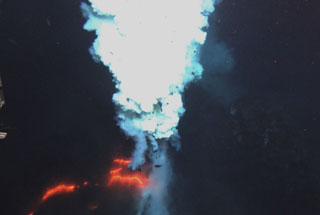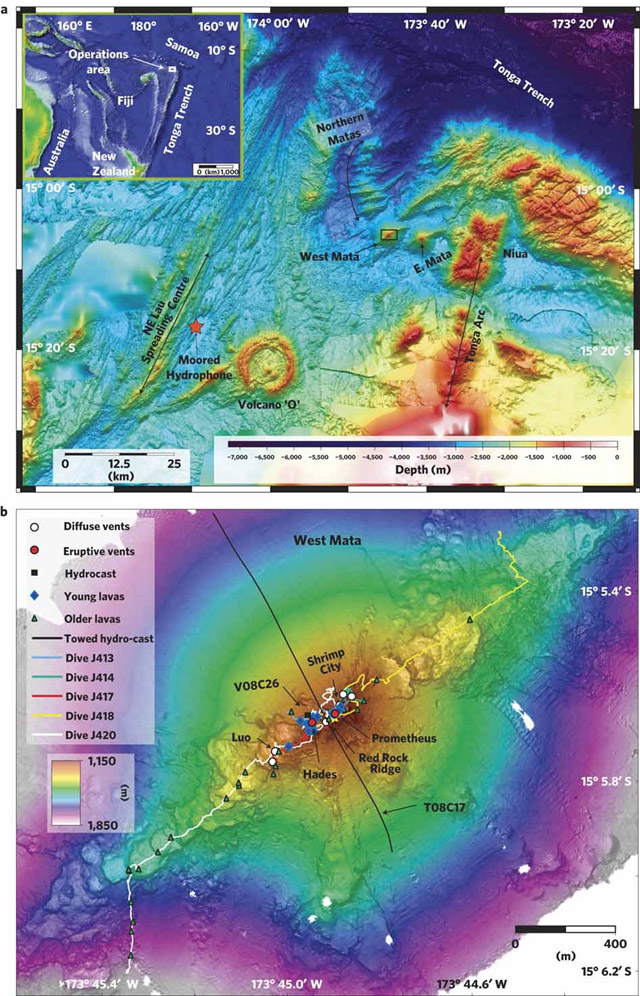Report on West Mata (Tonga) — December 2011
Bulletin of the Global Volcanism Network, vol. 36, no. 12 (December 2011)
Managing Editor: Richard Wunderman.
West Mata (Tonga) More details on the seamount and witnessed boninite eruptions
Please cite this report as:
Global Volcanism Program, 2011. Report on West Mata (Tonga) (Wunderman, R., ed.). Bulletin of the Global Volcanism Network, 36:12. Smithsonian Institution. https://doi.org/10.5479/si.GVP.BGVN201112-243130
West Mata
Tonga
15.1°S, 173.75°W; summit elev. -1174 m
All times are local (unless otherwise noted)
Scientists first detected signs of eruptions at West Mata, a small active seamount ~200 km SW of Samoa, in 2008 when a particle-rich plume was identified ~175 m above the volcano's summit (BGVN 34:06). An eruption site was located in May 2009 (Resing and others, 2011; BGVN 34:12), and found to be still active in March 2010 (Clague and others, 2011). Thus, as of the beginning of 2012, the W Mata eruption has been ongoing for at least 3 years (since November 2008). This report provides an updated version of the one that first appeared in BGVN 36:12 about W Mata volcano (figure 6).
Baker and others (2012) noted that W Mata volcano, a low effusion rate eruption, was the deepest active submarine eruption ever observed [as of 2011] and had both explosive and effusive phases. Hydrophones moored for two 5-month deployment periods before and after the 2009 seafloor observations recorded variable but continuous explosions, proof that W Mata, like Northwest Rota-1 (in the Mariana islands), is undergoing a lengthy eruption episode. Rubin and others (2012) reported that W Mata represented the deepest witnessed violent submarine eruption to this time (~700 m deeper than currently-erupting NW Rota-1 in the Mariana Islands, BGVN 29:03, 31:05, 33:12, 34:06, and 35:07).
It was previously thought that explosive eruptions, which involve expanding bubbles, shouldn't occur below a depth of ~1 km. Basically, as water pressure increases with depth in the ocean, the ability of gas to come out of solution in the magma and cause eruption is diminished. The suppression of bubbles thus limits explosions, but the depth at which this occurs is called into question. Clague and others (2011) suggest that pyroclastic activity at West Mata occurred to at least 2.2 km depth.
Presenting a list of ocean depths and locations where explosive processes have been documented, Clague and others (2011) gave the following information (presented here omitting their cited references): "...fine clastic debris formed during pyroclastic eruptions along [West Mata's] rift zones, and coarser talus shed from the lava flows, plateaus, and cones, can be traced upslope perpendicular to contours to the rift zones at depths as great as 2,350 m, suggesting that explosive pyroclastic activity on West Mata is common at least this deep, and much deeper than most theoretical models suggest without extraordinary initial volatile contents or accumulation of volatiles. Previous studies suggest that strombolian bubble-burst basalt eruptions occur along the mid-ocean ridge system for volatile-poor mid-ocean ridge basalt at least as deep as 1,600 m deep on Axial Seamount on the Juan de Fuca Ridge, 1,750 m on the mid-Atlantic Ridge near the Azores platform, 3,800 m on the Gorda Ridge, and 4,000-4,116 m deep on the Gakkel Ridge. Deep water strombolian activity of more volatile rich lavas has also been observed at 550-560 m depth on NW Rota-1 in the Marianas arc for basaltic-andesitic lava, and inferred at least as deep as 590 m depth off shore Oahu, 1,300 m at Lōʻihi Seamount, and 4,300 m for volatile-rich strongly alkalic lavas in the North Arch volcanic field. The distribution of clastic debris on West Mata suggests that boninite eruptions can also be pyroclastic much deeper than the activity observed at the active vents near the summit at 1,175-1,200 m depth."
Resing and others (2011) made the following introductory comments (quoted here without most of the references they cited): "Submarine eruptions account for ~75% of Earth's volcanism [White and others, 2006], but the overlying ocean makes their detection and observation difficult. The scientific community has made a concerted effort to study active submarine eruptions since the mid-1980s. Despite these efforts only two active submarine eruptions have been witnessed and studied: NW-1, a much shallower submarine volcano in the Mariana arc, and now West Mata, at 1,200 m depth. Here we describe sampling and video observations of an explosive eruption driven by the release of slab-derived gaseous H2O, CO2 and SO2. The generation of fine-sized clastic materials provides direct evidence for eruptive styles that produce similar materials deeper in the ocean."
Boninites. Resing and others (2011) and Rubin and others (2009) noted that among the first lavas to erupt at the surface from a nascent subduction zone are a type classified as boninites. A boninite sample was collected at W Mata by the ROV Jason during the 2009 cruise (see figures 10 and 11, BGVN 34:12). Boninite is a mafic extrusive rock, an olivine- and bronzite-bearing andesite with little to no feldspar, containing high levels of both magnesium and silica. The rock is typically composed of large crystals of bronzite (pyroxenes) and olivine in a crystallite-rich glassy matrix. These lavas are considered diagnostic of the early stages of subduction, yet, because most preserved and observable subduction systems on continents are old and well-established, boninite lavas had previously only been observed in the ancient geological record.
Resing and others (2011) found that large volumes of gaseous H2O, CO2, and SO2 were emitted, which they suggested are derived from the subducting slab. The volatiles drive explosive eruptions that fragment rocks and generate abundant incandescent magma-skinned bubbles and pillow lavas. Some examples of various eruptive modes observed in West Mata are shown in figure 7. As at other submarine volcanoes, the volatile-rich fluids found at West Mata fuel chemosynthetic biological activity (figures 7g and 7h).
In May 2009, scientists using ROV Jason 2 discovered two sites of active explosive eruption (vents) on the summit of W Mata (Resing and others, 2011). The first vent, Hades, was located on the S end of the summit ridge at ~1,200 m depth, and the second vent, Prometheus, was found ~100 m NE of Hades at 1,174 m depth (located in figure 6b). Figure 7 shows some newly published images from these vents. During a one-week study in 2009, explosive eruptions at both vents were almost continuous with only occasional quiet episodes. Several modes of magmatic gas-driven eruptions were identified and some may have contained significant trapped water. They produced pyroclasts (i.e., spatter, ash and tephra) and abundant fine-grained particulate material composed predominantly of sulfur.
The most spectacular eruptive mode observed during the week occurred when erupting gases stretched molten lava to create incandescent bubbles of ~0.2? to 1-m diameter (figure 7c and 7f ). As the lava bubbles burst they produced fine-grained particle clouds devoid of visible gas bubbles. A hydrophone placed nearby recorded distinctive low-frequency sounds.
In a less explosive eruptive mode, pulses of gas emitted pebble- and sand-size clastics (figure 7b). These formed mounds of debris through which magmatic gases escaped. Observers also saw pyroclasts and fine-grained sulfur (figures 7a-c and 7f).
Another eruptive mode occurred following quiet episodes, when cap rock was pushed aside and incandescent, degassing, molten lava emerged accompanied by low-frequency sound. At other times, the gas passing through the incandescent lava was flame-like in appearance. In both these cases, escaping hot volatiles insulated the incandescent lava from surrounding seawater for prolonged intervals.
The general absence of free gas bubbles at West Mata markedly contrasts with the abundance of bubbles observed at the much shallower (520 m) eruption at NW-Rota. This fits with the diminished ability to form bubbles at depth.
Clague and others (2011) reported that the autonomous underwater vehicle (AUV) D. Allan B conducted high-resolution (1.5-m scale) mapping during the May 2009 expedition to W Mata that helped identify the processes that construct and modify the volcano. In addition, ship-based multibeam sonar bathymetry had been collected over West Mata during expeditions in 1996, 2008, 2009, and 2010, with the results enabling comparisons over a 14-year period.
According to Baker and others (2012), a significant drawback to existing moored arrays is the absence of realtime information, precluding a prompt response to a detected event. This deficiency led to the addition of hydrophones to profiling floats and underwater ocean acoustic gliders. The QUEphone, or Quasi-Eulerian hydrophone, is a new-generation free-floating autonomous hydrophone with a built-in satellite modem and a GPS receiver (Matsumoto and others, 2006). Because it does not have station-holding capability, its main value to response efforts is its potential for rapid deployment by aircraft. Underwater ocean gliders offer a more structured monitoring strategy, as they can be preprogrammed to follow, and repeat, a horizontal and vertical course. Low instrument noise and buoyancy-based drive systems make gliders ideal acoustic monitoring tools, able to navigate around seafloor obstacles and resurface every few hours to transmit data. Matsumoto and others (2011) demonstrated this capability by driving a glider around W Mata volcano and recording the broadband volcanic explosion sounds.
References. Baker, E.T., Chadwick Jr., W.W., Cowen, J.P., Dziak, R.P., Rubin, K.H., and Fornari, D.J., 2012, Hydrothermal discharge during submarine eruptions: The importance of detection, response, and new technology, Oceanography, v. 25, no. 1, pp.128?141 [http://dx.doi.org/10.5670/oceanog.2012.11].
Clague, D.A., Paduan, J.B., Caress, D.W., Thomas, H., Chadwick Jr., W.W., and Merle, S.G., 2011, Volcanic morphology of West Mata Volcano, NE Lau Basin, based on high-resolution bathymetry and depth changes, Geochemistry, Geophysics, Geosystems (G3), v. 12, QOAF03, 21 pp, doi:10.1029/2011GC003791.
Matsumoto, H., Dziak,, R.P., Mellinger, D.K., Fowler, M., Lau, A., Meinig, C., Bumgardner, J., and W. Hannah, 2006, Autonomous hydrophones at NOAA/OSU and a new seafloor sentry system for real-time detection of acoustic events, Oceans 2006, MTS/IEEE?Boston, September 18?21, 2006, IEEE Oceanic Engineering Society, pp. 1-4, doi:.10.1109/OCEANS.2006.307041.
Matsumoto, H., Bohnenstiehl, D.R., Haxel, J.H., Dziak, R.P., and Embley, R.W., 2011, Mapping the sound field of an erupting submarine volcano using an acoustic glider, Journal of the Acoustical Society of America, v. 129, no. 3, pp. EL94?EL99, doi: 10.1121/1.3547720.
Resing, J.A., Rubin, K.H., Embley, R.W., Lupton, J.E., Baker, E.T., Dziak, R.P., Baumberger, T., Lilley, M.D., Huber, J.A., Shank, T.M., Butterfield, D.A., Clague, D.A., Keller, N.S., Merle, S.G., Buck, N.J., Michael, P.J., Soule, A., Caress, D.W., Walker, S.L., Davis, R., Cowen, J.P., Reysenbach, A-L., and Thomas, T., 2011, Active submarine eruption of boninite in the northeastern Lau Basin, Nature Geoscience, v. 4, 9 October 2011, pp. 799?806, doi:10.1038/ngeo1275.
Rubin, K.H., Soule, S.A., Chadwick Jr., W.W., Fornari, D.J., Clague, D.A., Embley, R.W., Baker, E.T., Perfit, M.R., Caress, D.W., and Dziak, R.P., 2012, Volcanic eruptions in the deep sea, Oceanography, v. 25, no. 1.p. 142?157 [http://dx.doi.org/10.5670/oceanog.2012.12].
Geological Summary. West Mata, a submarine volcano rising to within 1,174 m of the ocean surface, is located in the northeastern Lau Basin at the northern end of the Tofua arc, about 200 km SW of Samoa and north of the Curacoa submarine volcano. Discovered during a November 2008 NOAA Vents Program expedition it was found to be producing submarine hydrothermal plumes consistent with recent lava effusion. A return visit in May 2009 documented explosive and effusive activity from two closely spaced vents, one at the summit, and the other on the SW rift zone.
Information Contacts: Joseph A. Resing, NOAA PMEL and Joint Institute for the Study of the Atmosphere and Ocean (JISAO), The University of Washington, 7600 Sand Point Way, NE, Seattle, WA, USA (URL: http://www.pmel.noaa.gov and http://jisao.washington.edu); David A. Clague, Jennifer B. Paduan, David W. Caress, and Hans Thomas, Monterey Bay Aquarium Research Institute (MBARI), Moss Landing, California, USA (URL: http://www.mbari.org); William W. Chadwick Jr., Robert W. Embley, and Susan G. Merle, Hatfield Marine Science Center, Oregon State University and NOAA, Newport, OR, USA (URL: http://www.pmel.noaa.gov); Kenneth H. Rubin, Department of Geology and Geophysics, School of Ocean and Earth Science and Technology (SOEST), University of Hawaii at Monoa, HI, USA (URL: http://www.soest.hawaii.edu/).



